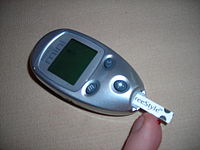
Photo from wikipedia
OBJECTIVE To compare the effect of an isocaloric multifactorial diet with a diet rich in monounsaturated fatty acids (MUFA) and similar macronutrient composition on pancreatic fat (PF) and postprandial insulin… Click to show full abstract
OBJECTIVE To compare the effect of an isocaloric multifactorial diet with a diet rich in monounsaturated fatty acids (MUFA) and similar macronutrient composition on pancreatic fat (PF) and postprandial insulin response in type 2 diabetes (T2D). RESEARCH DESIGN AND METHODS According to a randomized controlled parallel-group design, 39 individuals with T2D, 35-75 years old, in satisfactory blood glucose control, were assigned to an 8 week isocaloric intervention with a multifactorial diet rich in MUFA, polyunsaturated fatty acids, fiber, polyphenols, and vitamins (n = 18) or a MUFA-rich diet (n = 21). Before/after the intervention, PF content was measured by the proton-density fat fraction using a three-dimensional mDIXON MRI sequence, and plasma insulin and glucose concentrations were measured over a 4 h test meal with a similar composition as the assigned diet. RESULTS After 8 weeks, PF significantly decreased after the multifactorial diet (from 15.7 ± 6.5% to 14.1 ± 6.3%; P = 0.024), while it did not change after the MUFA diet (from 17.1 ± 10.1% to 18.6 ± 10.6%; P = 0.139) with a significant difference between diets (P = 0.014). Postprandial glucose response was similar in the two groups. Early postprandial insulin response (incremental postprandial areas under the curve [iAUC0-120]) significantly increased with the multifactorial diet (from 36,340 ± 34,954 to 44,138 ± 31,878 pmol/L/min; P = 0.037), while it did not change significantly in the MUFA diet (from 31,754 ± 18,446 to 26,976 ± 12,265 pmol/L/min; P = 0.178), with a significant difference between diets (P = 0.023). Changes in PF inversely correlated with changes in early postprandial insulin response (r = -0.383; P = 0.023). CONCLUSIONS In patients with T2D, an isocaloric multifactorial diet, including several beneficial dietary components, markedly reduced PF. This reduction was associated with an improved postprandial insulin response.
Journal Title: Diabetes care
Year Published: 2022
Link to full text (if available)
Share on Social Media: Sign Up to like & get
recommendations!